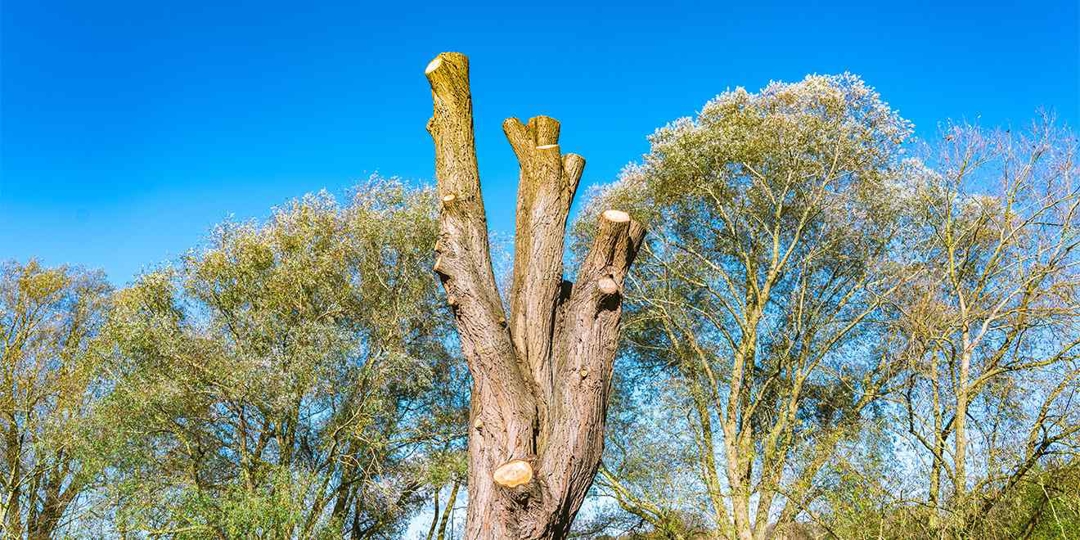If your tree grows too tall, threatening a home or ruining a view, what can you do? It can be tempting to just lop the ends off the highest limbs. But unlike your hair, trees don’t recover so easily when too much is “taken off the top.”
Learn more about this dramatic, ill-advised type of trimming—called tree topping—and how it affects trees.
First, What Is Tree Topping?
Tree topping is when a tree that’s deemed “too tall” has many—or all—its branches and limbs cut off. You’ve probably seen a local electric utility use tree topping as a quick way to get tall limbs away from power lines. This trimming, which is done to protect power lines without concern for aesthetics or health, leaves behind mangled-looking trees. Untrained tree trimmers may also use this technique as a “quick fix” that causes more problems in the long run.
Contrary to popular belief, it doesn’t prevent the tree from growing too tall again. Tree topping often leaves behind an ugly trunk that grows thin, broom-like branches instead of the majestic, spreading growth it once boasted. The topped tree often rapidly reaches the same height as it was before but with weaker, less beautiful growth.
Does Topping a Tree Hurt It?
Yes, topping a tree can harm the tree and significantly inhibit its natural, healthy growth. Fewer leaves (or no leaves at all, in extreme cases) mean the tree is getting almost no energy from the sun. Though new growth can sprout, it won’t be as strong or aesthetically pleasing as before the tree was topped.
Further, with so many limbs cut at once, trees can struggle to heal all the open wounds. Sometimes, the wounds never completely heal, as the tree puts its limited energy into creating new sprouts instead. The open cuts also create opportunities for insects and diseases.
Topped trees are at greater risk of falling because much of the remaining wood is liable to die off without nutrients from the sun. Cut limbs often die, posing a danger to people and structures below, until you have the deadwood removed.
Will a Tree Die If You Cut the Top Off?
Tree topping can kill trees, or simply lead to an early death. Topping a tree reduces its ability to get nutrients and leaves it open to pests and diseases. If new leaves don’t sprout fast enough, the tree has no way to get energy and will begin to die. The more often you top a tree, the greater your chances of weakening it until it dies off.
So, does topping a tree kill it? Maybe not right away, but topped trees frequently have shorter lifespans than non-topped trees.
Alternatives: What to Choose Instead of Topping a Tree
Luckily, there are non harmful ways to reduce the size of your tree or to prevent it from growing too tall.
Trimming Tall Trees vs. Topping Them
The best thing to do is be proactive.
If you think your tree is starting to get too tall, trimming or pruning control its growth without the harm of topping. A professional arborist can also apply plant growth regulators to slow down growth without harming the tree.
If your tree is already too tall, talk to an arborist about more aggressive pruning. One of our trained tree health care specialists will tell you how much we can reduce your tree’s height before it becomes dangerous for the tree’s health.
While trimming or pruning a tree, Monster Tree Service arborists look for healthy, balanced ways to remove branches to reduce the height of the tree while leaving it strong. We also trim away potential problems, like overhanging branches, to keep your property safe.
Tree Topping vs. Crown Reduction
During a crown-density reduction (also known as crowning), a professional arborist will selectively thin branches to allow more air and sunlight to pass throughout the tree. The process can also slightly reduce the diameter of your tree’s crown, but not as dramatically as pruning.
When it comes to tree crowning vs. topping, a crown-density reduction is the obvious choice. Our skilled arborists avoid taking too many branches at once, so your tree has a chance to heal itself properly. A crown reduction is ideal for a tree that looks imposing but isn’t necessarily too tall.
The increased air and sunlight into your tree’s crown encourage healthy growth in the remaining branches. We leave plenty of leafy branches to continue supplying your tree with nutrients from the sun. Any new growth will follow the tree’s natural growth pattern, maintaining the beautiful silhouette of your tree.
Choose Crown Reduction from Professional Arborists
We hope after reading this you would never choose an arborist who uses harmful and outdated practices like tree topping. Monster Tree Service arborists are trained in the best and least harmful ways to trim trees.
Schedule crown reduction or trimming and pruning services for dedicated care. Request an estimate online or call (888) 744-0155 today to schedule pruning services that keep your tree’s health and your yard’s beauty in mind.

